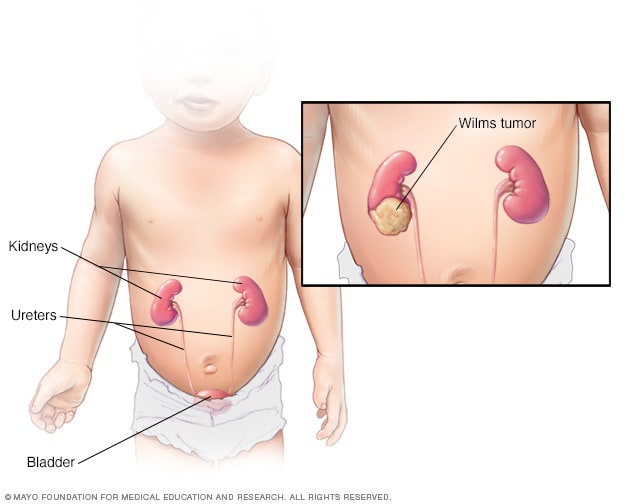Overview
Wilms tumor

Wilms tumor
Wilms tumor is the most common type of kidney cancer in children. The kidneys are part of the urinary system, which removes waste from the body through urine. The urinary system also includes the ureters, bladder and urethra.
Wilms tumor is a rare kidney cancer that mainly affects children. Also known as nephroblastoma, it's the most common cancer of the kidneys in children. Wilms tumor most often affects children ages 3 to 4. It becomes much less common after age 5, but it can affect older children and even adults.
Wilms tumor mostly occurs in just one kidney. But it can sometimes be in both kidneys at the same time.
Over the years, progress in the diagnosis and treatment of Wilms tumor has greatly improved the prognosis for children with this disease. With treatment, the outlook for most children with Wilms tumor is good.
Products & Services
Symptoms
Symptoms of Wilms tumor vary a lot. Some children don't seem to have any symptoms. But others with Wilms tumor have one or more of these symptoms:
- A mass in the stomach area that can be felt.
- Swelling in the stomach area.
- Pain in the stomach area.
Other symptoms might include:
- Fever.
- Blood in the urine.
- Low red blood cell level, also known as anemia.
- High blood pressure.
When to see a doctor
Make an appointment with your child's health care provider if you see symptoms that worry you. Wilms tumor is rare. So it's likely that something else is causing symptoms. But it's important to check out any concerns.
Causes
It's not clear what causes Wilms tumor.
Cancer begins when cells develop changes in their DNA. Cells' DNA holds the instructions that tell the cells what to do. The changes tell the cells to grow and multiply quickly. The cancer cells live while healthy cells die as part of their natural life cycle. With Wilms tumor, the changes make extra cells in the kidney that form the tumor.
Rarely, DNA changes passed from parents to children can increase the risk of Wilms tumor.
Risk factors
Factors that may increase the risk of Wilms tumor include:
- Being Black. In North America and Europe, Black children have a slightly higher risk of getting Wilms tumor than do children of other races. Asian-American children appear to have a lower risk than children of other races.
- Having a family history of Wilms tumor. Having someone in the family who's had Wilms tumor increases the risk of getting the disease.
Wilms tumor occurs more often in children who have certain conditions present at birth, including:
- Aniridia. In aniridia (an-ih-RID-e-uh), the colored portion of the eye, known as the iris, forms only in part or not at all.
- Hemihypertrophy. Hemihypertrophy (hem-e-hi-PUR-truh-fee) means one side of the body or a part of the body is larger than the other side.
Wilms tumor can occur as part of rare syndromes, including:
- WAGR syndrome. This syndrome includes Wilms tumor, aniridia, genital and urinary system problems, and intellectual disabilities.
- Denys-Drash syndrome. This syndrome includes Wilms tumor, kidney disease and male pseudohermaphroditism (soo-do-her-MAF-roe-dit-iz-um). In male pseudohermaphroditism, a boy's genitals aren't clearly male.
- Beckwith-Wiedemann syndrome. Children with this syndrome tend to be much larger than what is typical, known as macrosomia. This syndrome might cause organs in the stomach area to jut into the base of the umbilical cord, a large tongue, large internal organs and ears that are formed unusually.
Prevention
Wilms tumor can't be prevented.
If a child has any of the conditions that increase the risk for Wilms tumor, a health care provider might suggest doing kidney ultrasounds at times to look for anything unusual in the kidneys. Although this screening can't prevent Wilms tumor, it may help find the disease at an early stage.